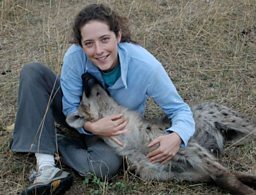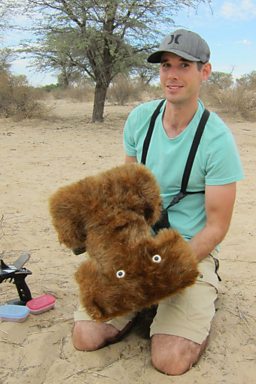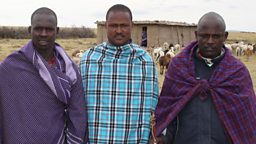Meet the experts from episode 2
To be able to make like a real-life Dr Doolittle and talk to the animals, Lucy Cooke had to travel the world - luckily these experts were on hand to help her...
Hyenas with Sarah Benson-Amram
Sarah, from the Department of Zoology and Physiology at the University of Wyoming, investigates the complex cognitive abilities of hyenas, as well as their ability to learn about and adapt to their environments.
Sarah says, ‘Disney’s “The Lion King” portrays hyenas as idiotic scavengers. In reality, hyenas are actually talented hunters that kill 80% of their own food. They also live in large groups with complex social politics’.
Chickadees with Carrie Branch
Carrie is a Ph.D. Student at the University of Nevad-Reno. She’s interested in the role of vocalisations in the life of these birds including how they choose mates and respond to predators.
Carrie says: “The [chickadees’] call system has even been likened to human language in that it is made up of several discrete note types that can be combined to form a potentially endless communication system. Plus, they’re absolutely adorable!”
Bats with Dr Rachel Page
Rachel is a Panama Research Scientist at the Smithsonian Tropical Research Institute. She’s interested in the cognitive behaviour of animals, specifically the complexities of how frog-eating bats eavesdrop on their prey.
Rachel says, “Based on the frog call alone, these bats can tell if the frog is palatable or poisonous, too big or the right size to eat.”
Ground squirrels and rattlesnakes with Professor Rulon Clark
In 2011 Rulon, Associate Professor of Biology at the San Diego State University, and his team made waves in the scientific community with their robotic squirrel experiments. These novel experiments are being used to explore how squirrels can alter the hunting behaviour of their rattlesnake predators.
Previous research with robosquirrel by Dr Aaron Rundus discovered the first example of 'infrared communication' in the animal world. Rattlesnakes are able to see in the infrared spectrum, and by heating up their tails, the squirrels can send them messages, even in the dark!
Horses with Professor Karen McComb
Karen established the Mammal Vocal Communication Research Group at Sussex University with her colleague David Reby. Her work involves playback experiments; where animals’ vocalisations are recorded and then played back them. By studying their behaviour Karen has gained powerful insight into the minds of animals including elephants, red deer, lions, horses and even domestic cats.
Karen says, “When we hear a familiar voice we form a mental picture of who spoke. We match visual and auditory cues to recognise specific individuals” Karen’s work shows that horses do this too.
Dolphins with Dr Vincent Janik
Vincent is a member of the Sea Mammal Research Unit and the Centre for Social Learning and Cognitive Evolution at the University of St Andrews. His expertise is within the field of animal communication specialising in marine mammals. Much of this work concentrates on the bottlenose dolphin as they exhibit similarities in communication skills to humans. These skills include vocal learning, social memory and the ability to recognise one another.
Drongos and meerkats with Dr Thomas Flower
Thomas, a Postdoctoral Fellow at the Percy Fitzpatrick Institute of African Ornithology, started working in the Kalahari in 2003. Thomas’s work has shown that drongos make alarm calls to warn meerkats that predators are around even when there’s no danger. The calls scare off meerkats, allowing the drongos to steal their abandoned food. Although meerkats get wise to this and ignore the calls, drongos have the ability to mimic other species’ alarm calls which the meerkats recognise, which means they can carry on stealing food.
Honeybees with the Maasai
In East Africa, Massai tribesmen have entered into a mutually beneficial arrangement with a wild bird, the greater honeyguide, in order to find both their favourite food – honey.
African bees are highly migratory; their nests continually move and searching for them without the help of the honeyguide is time and energy consuming. The Massai have a special whistle which summons the bird; the bird in turn will guide them straight to a hive saving hours of searching. The birds can’t access the honey, grubs and wax as easily as the Massai, and the beestings are potentially fatal to them; this way both human and bird get fed.



Find out more
-
![]()
Find out more about who'll be talking with the animals in episode 1
-
![]()
Lucy reveals which animals she loved chatting to


